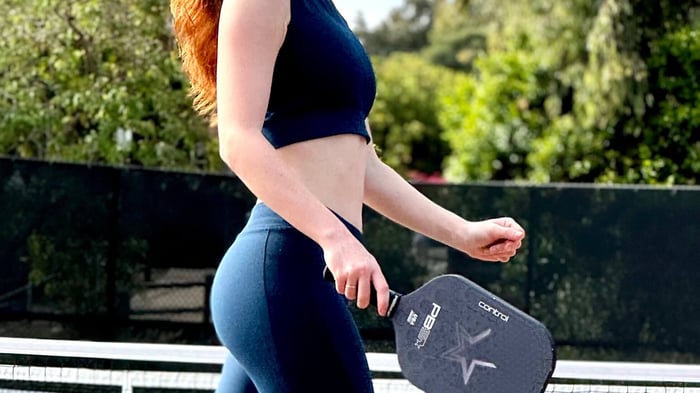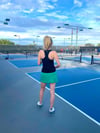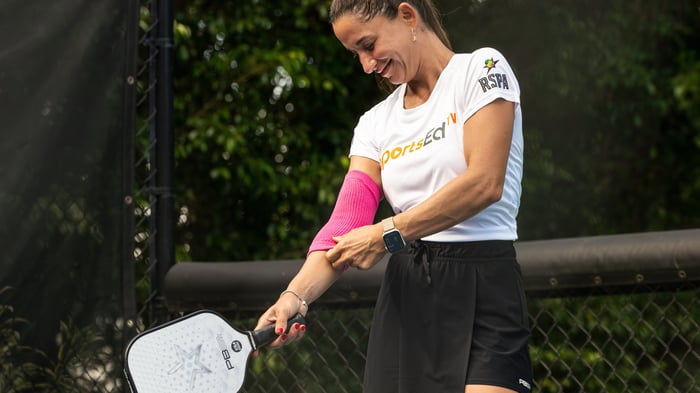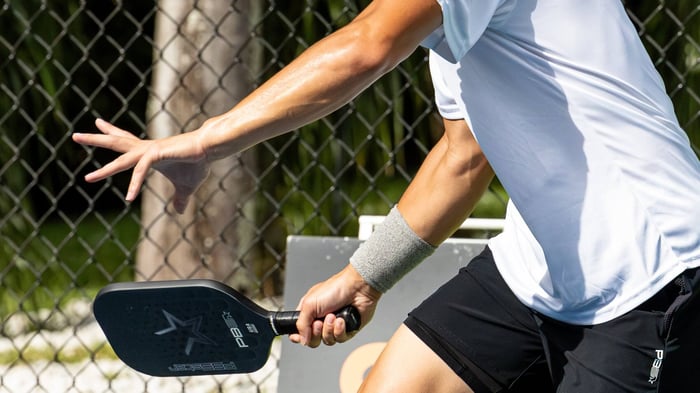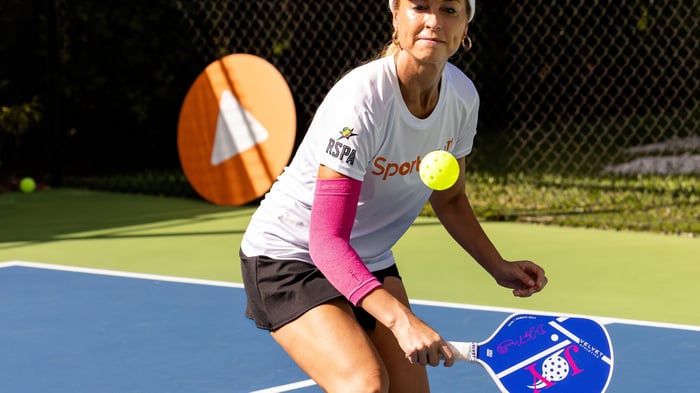Key takeaways:
Advanced pickleball drills focus on building nuanced skills like rapid decision-making, precise shot placement, and seamless transitions under match-like pressure.
Mastering drills such as the third shot drop, dinking under pressure, and transition zone footwork can transform your game from recreational to competitive dominance.
Combining deliberate practice with performance-ready apparel enhances your training experience, ensuring comfort, mobility, and confidence on the court.
Moving from a solid recreational player to a dominant league competitor takes more than just court time; it takes focused, intentional practice. Advanced pickleball drills are designed to push you beyond your comfort zone, helping you develop the high-level skills that truly matter when the pressure’s on. While basic drills are great for building a foundation, advanced training sharpens your ability to make quick decisions, place shots with precision, and shift effortlessly between offense and defense. Over time, these drills build muscle memory so you can rely on instinct in fast-paced rallies and close out tight games with confidence.
This isn’t just another set of practice routines. The seven advanced drills we’ve pulled together are specifically designed to target the gaps that often limit experienced players. Whether it’s reinforcing middle-court dinking, improving court positioning, or turning defensive plays into offensive opportunities, each drill has a purpose, and it’s all about making you a smarter, more confident competitor. And when you're training in performance-ready gear that keeps up with every sprint, lunge, and pivot, you’ll feel the difference. Explore our Game Gear collection designed for players who expect more from their gear and from themselves.
Let’s dive into the drills that can help unlock your next level of play.
What makes a pickleball drill advanced?
Advanced pickleball drills do more than just sharpen your technique; they replicate the intensity, pressure, and split-second decisions you face in real matches. These drills are designed to challenge both your body and your mind, combining physical execution with strategic thinking. You’re not just hitting a shot; you’re choosing between a reset or an attack, adjusting your positioning to protect the middle, and communicating instinctively with your partner, all while managing fatigue and fast-paced play. This kind of training helps you develop the ability to perform under pressure, not just in practice but when it matters most.
What makes these drills so effective is how they force you to adapt. When you repeatedly practice complex movements and precise shot placement under high-stress conditions, your body starts to respond automatically. You build the confidence to make smart choices and execute with precision, turning match-day nerves into sharp focus. This is the difference between playing well and playing like a champion.
#1. Mastering the third shot drop drill
The third shot drop is one of the most important transition shots in pickleball, helping you move from baseline defense into strong net positioning. A well-placed drop into your opponent’s non-volley zone takes away their ability to attack and gives your team time to move forward. The “0 to 60” drill replicates match-like pressure by requiring players to hit consistent, controlled drops while switching roles on missed shots. It’s an excellent way to sharpen technique and mental focus under stress.
The key to mastering this drill is learning to control height and tempo. You want just enough arc to clear the net but not so much that your opponent can attack. Repeating this motion develops soft hands, reliable paddle angles, and muscle memory you can count on when the pace picks up. Over time, you’ll stop seeing third-shot drops as a challenge and start using them as a strategic weapon to take control of points early.
#2. Transition zone footwork drill
The transition zone, that tricky space between the baseline and the kitchen line, is where many rallies are won or lost. This drill trains you to move through that space with purpose, rather than getting stuck and becoming a target. It emphasizes explosive footwork, quick adjustments, and court awareness that help you go from defense to offense without hesitation.
The heart of this drill lies in mastering the split-step. This small hop before your opponent hits allows you to stay balanced and react in any direction. Paired with cone drills and directional changes, you’ll learn to keep your feet light and your positioning sharp. Over time, you'll find yourself arriving at shots earlier and more prepared, turning awkward scrambles into confident plays that put pressure back on your opponents.
#3. Resetting from the kitchen line
When the action heats up at the kitchen line, resets can make or break a rally. A solid reset neutralizes an opponent's attack, turning chaos into control. This drill teaches you to absorb pace, maintain paddle control, and stay composed when under pressure. It’s not about matching their power; it's about finding the calm within the storm and guiding the ball back into the non-volley zone with soft, deliberate touch.
The technique starts with a good paddle position and relaxed hands. Using drop steps and smooth footwork, you create the space you need to reset, even when pushed off balance. The more you practice this, the more natural it feels to stay steady and patient when others speed up play. Mastering this drill adds a vital layer to your defense and gives you the confidence to hold your ground at the net during intense exchanges.
#4. Defensive lob recovery challenge
A well-placed lob can flip a rally in an instant, especially when it pulls you away from the net and into a tough defensive position. This drill helps you read lobs early, move efficiently, and recover in time to reset or even counterattack. It trains your ability to track the ball, adjust your positioning mid-rally, and maintain balance while preparing for your return.
For doubles, communication becomes just as important as footwork. This drill simulates real match dynamics by adding partner callouts and recovery coordination, so you always know who's covering what. You’ll not only develop quick reactions and court coverage but also the teamwork and trust needed to turn defensive situations into opportunities to regain control.
#5. Fast-paced hand speed drills
At the kitchen line, lightning-fast reflexes often decide the outcome of a rally. This drill puts you and a partner just feet apart in the non-volley zone, forcing you to react instantly to rapid volleys. The close distance compresses your reaction window, helping you develop instinctive paddle control and sharper timing under pressure.
As you add multi-ball feeds or increase rally tempo, your hands learn to reset quickly between forehand and backhand volleys while maintaining composure. Over time, this kind of repetition boosts your confidence in high-speed situations and gives you the edge during fast-paced exchanges when most players are just trying to survive.
#6. Angle control training for sharp winners
Smart players know it’s not always about power, it's about placement. This drill helps you learn how to hit sharp angles that pull your opponent off the court, creating openings and forcing difficult returns. By adjusting your paddle face and using footwork to position yourself, you’ll learn to create deceptive, hard-to-reach winners from a variety of setups.
Practicing cross-court and down-the-line shots with specific targets helps you develop muscle memory for those finishing plays. With enough repetition, you’ll be able to disguise your intentions and hit winning angles under pressure. It’s a subtle but game-changing skill that separates tactical players from those who rely solely on speed or strength.
#7. Advanced serve placement for tactical advantage
A strategic serve can do much more than start a rally; it can immediately put your opponent on the defensive. This drill focuses on developing accuracy, spin, and depth with a variety of serve types aimed at specific zones on the court. When you can consistently hit deep corners or pull opponents wide, you control the flow of the point from the very beginning.
Adding pace, spin, or directional changes keeps your opponent guessing and prevents them from settling into a rhythm. You’re not just serving to get the ball in; you’re setting the stage for your next move. With regular practice, your serve becomes a strategic asset that forces errors, creates weak returns, and puts you in charge from the first shot.
Frequently asked questions about advanced pickleball drills
Competitive players often have specific questions about optimizing their training routines and maximizing the effectiveness of their practice sessions. These common pickleball training FAQ topics address the practical aspects of implementing advanced drills into your competitive development. Understanding these fundamentals helps you build a systematic approach that accelerates your progress toward elite-level play.
What equipment or gear is recommended for advanced pickleball training?
Beyond a quality paddle and balls, training benefits from cones for footwork drills, a ball machine for consistent feeds, and targets for precision practice. Our PB5 Court2 shoes provide the Dynamic Stability Assist™ and lightweight design that competitive players need during intense drill sessions, offering excellent traction for the quick sprints and sharp pivots required in transition zone footwork. Performance-ready apparel that moves with your body becomes crucial during extended practice, allowing you to focus on technique rather than adjusting uncomfortable clothing that restricts your movement.
Are these drills suitable for solo practice, or do they require a partner?
Most of these drills require a partner or coach to create the realistic pressure and ball feeds that simulate competitive match conditions. However, you can adapt several drills for solo practice using a ball machine or wall work, particularly for serve placement, footwork patterns, and basic stroke mechanics. The communication and tactical elements that make these drills truly game-changing can only be developed through partner practice that replicates doubles coordination.
What are common mistakes to avoid when performing these drills?
The biggest mistake is practicing drills at a comfortable pace rather than match intensity, which fails to develop the pressure responses needed during competition. Many players also focus on power over precision, missing the point that advanced techniques emphasize movement efficiency and shot placement rather than raw strength. Avoid practicing drills in isolation without connecting them to game situations, as this limits your ability to transfer skills from practice to actual match play.
Take your game further with PB5star
These ten advanced drills aren’t just about building skill; they’re about pushing your limits. From explosive transitions to rapid-fire exchanges and sharp footwork at the kitchen line, every movement demands gear that can keep up. That’s why PB5star performance apparel is designed for serious players. Our lightweight, high-performance fabrics do more than wick away sweat; they move with you, support your body through every pivot and slide, and stay comfortable through even the most intense training sessions.
In the PB5star community, the players who keep leveling up all understand one thing: when you feel good and look confident, you perform better. The connection between premium gear and focused training creates the mindset and environment where real progress happens. When you combine serious drill work with apparel designed for movement, comfort, and style, you’re not just training harder, you’re stepping into a network of players who expect more from themselves and their gear. Explore our exclusive collection and experience how the right clothing can elevate every session, every match, and every moment on the court.



